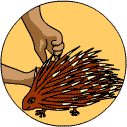How To Pick Up A Porcupine - A Personal Perspective
Created | Updated Aug 3, 2005

When picking up a young porcupine use duct tape on the quills to keep them down. The tape does not harm the owner of the quills. Once the quills are taped down, the little creature can be picked up and placed on your lap just as easily as any other little creature of its size1.
A Personal Porcupine Perspective
The following is a first-hand account of handling a young porcupine:
Porcupines are entirely fearless. The one which spent two nights in my house before we gave it to the zoo was brought to us from the wild, because its mother had been killed (perhaps to be eaten by the villagers whose farms porcupines visit regularly) by stepping on an exposed electric cable. The young animal was brought to my house wrapped in a towel and then transported in a plastic basket so that the other villagers on the bus would not worry it to death.
It showed absolutely no tension or anxiety when it was unwrapped and instead fell asleep just as soon as it got over hearing me exclaim, 'How sweet!' very loudly and very frequently.
The villager who brought it to us assured us that it would be very active at night. He was absolutely right. Around 7.00pm it woke up like a torch which has been switched on. I say 'it' because no one was sure whether it was male or female. It didn't appear to have any masculine appendages (I did once see a tiny graphic illustration of how porcupines who are in a romantic mood manage to bring their rear ends together - the illustration showed two porcupines in silhouette apparently lying on their sides with their snouts pointing away in opposite directions and their rear-ends joined in a highly suggestive manner. I have no idea whether this is the final word on porcupine conjugations, but thought it would be useful to include the information) so we thought of it as female.
It continued to show no fear at all of us or of anything else. It did not appear to be distressed. It ate carrots and a bit of banana. What we noticed was that its quills responded to every slightest sound. A word about the quills. Though the creature was quite small, suggesting that it was at most a couple of months old, it had a full back of handsome black-and-white-striped quills. They were not as long as an adults' would be, but were certainly pierce-enabled. So it looked exactly like an adult which had been passed through a Xerox machine and reduced to lap-dog size. At rest, the quills lay in a smooth-ish stack along its back. The least sound caused them to be raised, though they were also raised randomly, such as when the porcupine encountered the leg of a bed or the desk or some other thing new to its experience. When alarmed by something, our little friend merely backed into it.
We concluded that since no jungle animal in its right mind, including a tiger, will mess with porcupines, they have evolved without knowing real fear. It was quite astonishing to meet a wild mammal which had no 'biting' response to being handled. Its ears were not like the ears of mice or rats - porcupines belong to the rodent family - being much closer in shape to our own, and hairless. The paws were very sweet, with separate fingers but no real thumb of course. When the young porcupine lay down to rest, it spread its hind limbs backwards and front limbs forwards, the way that some puppies do. It had no real fur anywhere, its naked skin being a sort of muddy grey. It offered no surface ideal for petting or tickling except its head, where there was a rather endearing crest of sparse, wiry hair. It seemed to like being scratched behind its ears. We didn't try its belly because it wasn't exactly easy to handle even with the duct tape.
When we took it to the zoo we took the tape off. It lay without any fuss or struggling in my lap during this operation for which we had to use a bit of spirit. Only one or two quills came loose. They are not firmly attached after all, which is why they stick into things that the porcupine backs into, and it even went to sleep for a bit, since it took a while to do. All of which suggests to me that the tape did not harm it much at all.
The reason we took it to the zoo was that one of the senior members of the household violently rejected the idea of keeping our friend as a pet because, she argued, it would be impossible to live in an apartment with a grown porcupine waddling about. We had to agree and regretfully gave the little one away before we grew too attached to it.
It would probably not be a great idea to try to pick up an adult porcupine with or without duct-tape.
1The Researcher reported that in the case of the young porcupine they actually picked up, it 'was like a miniature dachshund, but heavier'.

